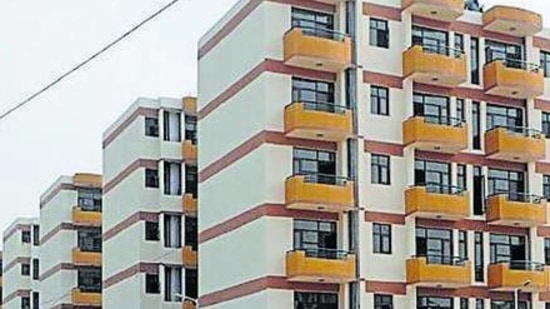The Economic Survey released on July 22 emphasized on the real estate sector’s recovery after the pandemic, driven by factors like urbanization, government schemes such as the Pradhan Mantri Awas Yojana (PMAY) and other affordable housing initiatives. The first quarter of 2024, witnessed record-breaking sales of 1.2 lakh units, clocking a robust 41% YoY growth, it noted.

It said that the outlook for the real estate sector is encouraging. It projected a positive outlook for the real estate sector with housing demand set to rise on rapid urbanisation, but noted that legacy stalled projects were a “challenge”.
“Real estate and ownership of dwellings have accounted for over seven per cent of the overall GVA (gross value added) in the past decade, highlighting their integral role in the economy,” the survey said, which was tabled in the Parliament by Union Finance Minister Nirmala Sitharaman.
“The outlook for the real estate sector is encouraging. With increasing urbanisation, the housing industry is poised for a significant transformation,” the economic survey said.
It noted that in 2023, residential real estate sales in India were at their highest since 2013, witnessing a 33% YoY growth, with a total sale of 4.1 lakh units in the top eight cities. The new supply witnessed an all-time high, with 5.2 lakh units launched in 2023, as against 4.3 lakh units in 2022. The momentum continued in Q1 of 2024, witnessing record-breaking sales of 1.2 lakh units, clocking a robust 41% YoY growth, the Economic Survey said on July 22.
The Economic Survey tabled in Parliament on July 22 said that India’s GDP is likely to grow at 6.5 to 7 per cent in the current fiscal year amid global challenges which may impact exports. The growth projected for 2024-25 is lower than the economic growth rate of 8.2 per cent estimated for the previous financial year.
Stating that half of India’s population is projected to dwell in urban regions by 2050 compared to 31% in 2011, the survey stressed the need to adapt strategies and policies to meet the rising demand for housing.
The survey also pointed out that “the legacy stalled real estate projects is a challenge.” Approximately 4.1 lakh stressed dwelling units, involving ₹4.1 lakh crore, are affected as estimated by the Indian Banks’ Association (IBA).
New housing supply has consistently exceeded one lakh units since Q2 of 2022, underscoring persistent demand-supply dynamics in the housing market, it noted. Further, the rising demand for housing loans reflects the underlying demand for real estate, it said.
According to a report by Crisil, the housing loan market in India grew at a CAGR of approximately 13% from FY18 to FY23. It is expected to continue growing at a CAGR of 13 to 15% reaching ₹42 lakh crore to ₹44 lakh crore by FY26.
NHB has introduced a Residential Mortgage-Backed Securities (RMBS) platform to address funding options limitations. This platform aims to attract long-term resources from diverse investor groups, including Pension Funds and Insurance Funds, to support the expansion of housing finance and deepen the debt market for primary mortgages. “The RMBS platform will help reduce asset liability mismatches for lending institutions, ensuring adequate liquidity in the housing finance sector,” the Economic Survey noted.
It noted that housing loans as a percentage of GDP increased from FY12 to FY24. Traditionally, banks have been the most significant players in the housing finance sector. However, Housing Finance Companies (HFCs) have significantly contributed to this landscape over the years. They played a complementary role with banks in providing housing credit to the bottom of the pyramid. The share of outstanding housing loans as a percentage of total loans of HFCs stood at 70.8% as of March 31, 2024, it said.
Factors that contributed to housing sector’s growth
The Economic Survey noted that the housing sector’s growth has been due to several key factors. The Pradhan Mantri Awas Yojana-Urban (PMAY-U), launched in 2015, has sanctioned over 1.2 crore houses for urban beneficiaries, ensuring durable housing.
Policy reforms like the Goods and Services Tax, Real Estate (Regulation and Development) Act, and the Insolvency and Bankruptcy Code have boosted transparency and investor confidence in real estate.
Initiatives like the Affordable Housing Fund and Special Window for Affordable and Mid-Income Housing (SWAMIH) Investment Fund have supported affordable housing projects, it noted.
PMAY(U)-Credit Linked Subsidy Scheme interest subvention has been a primary demand-side driver, with the National Housing Bank (NHB) releasing ₹49,460.1 crore in subsidies benefiting over 21.1 lakh households by March 2024. The co-lending model, combining bank liquidity with HFCs’, aims to extend housing credit to a broader segment, including low-income groups. The Urban Infrastructure Development Fund, managed by NHB with an initial corpus of ₹10,000 crore, is expected to improve urban infrastructure, attracting real estate investment.
Outlook encouraging going forward
“The outlook for the real estate sector is encouraging. With increasing urbanisation, the housing industry is poised for a significant transformation,” it said.
As per the United Nations, by 2050, half of India’s population is projected to dwell in urban regions, compared to 31% in 2011. This underscores the need to adapt strategies and policies to meet the rising demand for housing and offer viable, cost-effective, sustainable solutions.
Digitisation of land records is poised to improve transparency in land transactions, diminish property ownership conflicts, and enhance the efficiency of land management, it noted.
Implementing a single-window clearance system for construction approvals will also accelerate construction processes, minimising delays and uncertainties. The streamlining of approvals is set to consolidate and systematise India’s residential real estate sector further, the Economic Survey said.
“Going forward, the demand for housing is expected to be driven by affordability and increased access to credit. As of March 2024, the shares of Southern, Western and Northern states in the individual housing loans outstanding are 35.4%, 31.2% and 26.2%, respectively,” it noted.
The Eastern States at 6.9% and the eight North-eastern and Hilly states combining to 0.95% share present an opportunity for undertaking initiatives for improving penetration.
Sustainability and technology have emerged as significant disrupters for the real estate sector. Sustainability will influence green construction practices and energy-efficient designs, while technology will revolutionise smart homes and data-driven insights. With more significant environmental concerns, the focus will be on energy-efficient systems, rainwater harvesting and smart building technologies, it said.
According to Anuj Puri, chairman – ANAROCK Group, the survey mentions an increase in real estate investments, both local and international which have been supported by changes like the Real Estate (Regulation and Development) Act (RERA). Furthermore it emphasizes how infrastructure development, including projects focused on cities and urban transportation, plays a role in stimulating nation-wide real estate demand and growth.






Join The Discussion